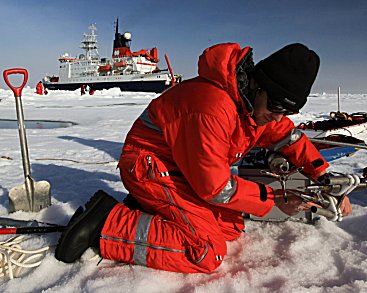Antje Boetius, Alfred Wegener Institute (AWI), Bremerhaven, Germany, and colleagues investigated the short-term reaction of the deep sea ecosystem to changes in sea ice cover in Summer 2012. Frank Wenzhöfer, Helmholtz-Max Planck, Germany, was for the first time able to measure the bacterial and faunal oxygen consumption directly in the deep sea of the ice-covered Arctic using micro-sensors.
Huge quantities of algae, mainly Melosira arctica, are growing on the underside of the sea ice in the Central Arctic. When the ice melts and sea ice gets thinner, as was the case during the ice minimum in 2012, ice algae were found to grow faster. It has been known for some time that diatoms of the type Melosira arctica can form long chains under the ice. They are heavy and can quickly sink to the bottom of the sea to a depth of several thousands of metres.
The massive occurrence of this in 2012 had previously only been described for coastal regions and old, thick sea ice. Normally, the small phytoplankton cell sinks only very slowly through the water column and is largely consumed within the ocean surface layer. In 2012 the algae exported more than 85 % of the carbon fixed by primary production from the water surface to the deep sea. Deep sea animals such as sea cucumbers and brittle stars feed on the algae. Bacteria decomposed the algae as evident from a greatly reduced oxygen content in the sediment.
Image: ©: Karl Attard, NIOZ/Alfred Wegener Institute
- Export of algal biomass from the melting Arctic sea ice,
Antje Boetius, Sebastian Albrecht, Karel Bakker, Christina Bienhold, Janine Felden, Mar Fernández-Méndez, Stefan Hendricks, Christian Katlein, Catherine Lalande, Thomas Krumpen, Marcel Nicolaus, Ilka Peeken, Ben Rabe, Antonina Rogacheva, Elena Rybakova, Raquel Somavilla, Frank Wenzhöfer,
Science 2013.
https://doi.org/10.1126/science.1231346




